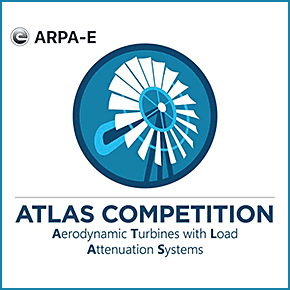ATLAS: Offshore Wind Challenge
This contest is over.
Click here for current contests.
Click here for current contests.
 Deadline: 2019-04-19
Deadline: 2019-04-19Award: $175,000
Open to: Everyone*
The Advanced Research Projects Agency – Energy (ARPA-E) of the U.S. Department of Energy is challenging the research and industrial communities to discover, develop, and test innovative and disruptive Control Co-Design solutions for critical wind energy challenges. The ATLAS (Aerodynamic Turbines with Load Attenuation Systems) Competition is the first ARPA-E effort associated with this advanced design methodology.
In both Challenges, the primary objective is to reduce the mechanical fatigue of the main system components without compromising the Annual Energy Production (AEP). Leveraging algorithms that are successful, future designers would be able to propose more reliable, more resilient and more optimal turbine designs, reducing the associated Levelized Cost Of Energy (LCOE) of the wind turbine.
Collective pitch control (CPC) regulates the rotor speed (Wr) of wind turbines when the turbine is experiencing wind conditions above the rated speeds –i.e., with wind velocities typically above 11 m/s. CPC changes the pitch angle of the three blades (b1, b2, b3) identically and simultaneously to regulate the rotor speed under variable wind –see Fig.1. CPC is the common solution applied in commercial multi-megawatt turbines. However, CPC does not consider the asymmetry of the wind velocity profile over the rotor area, which could introduce large unbalanced loads in the system.
Individual pitch control (IPC) is an innovative technique that considers these wind asymmetries. It has the potential to reduce the associated asymmetric mechanical loads on the blades, minimizing the mechanical fatigue of the structure (nacelle, tower, floating platform, mooring system, etc.) without significantly compromising the average of power generation. In addition to the CPC signal (bcpc), the IPC adds to each pitch motor an individual control signal (bipc1, bicp2, bipc3) to reduce the asymmetric loads. Calculations of these individual control signals can be based on the information provided by sensors that measure directly or indirectly the bending moments of each blade (M1, M2, M3), the rotor azimuth (f), and advanced control algorithms
* Details may apply. See contest website to confirm eligibility.
Notify me of new challenges!
